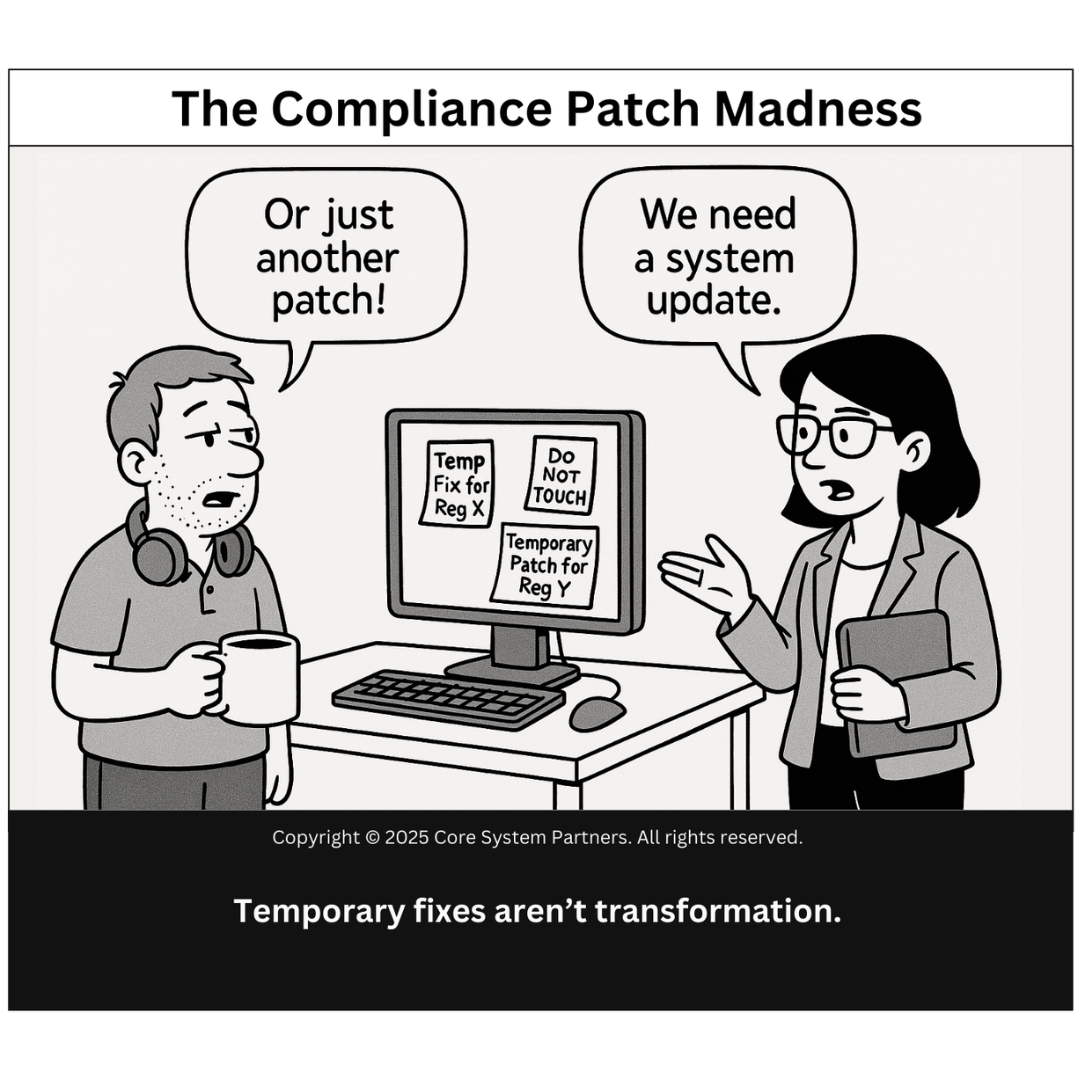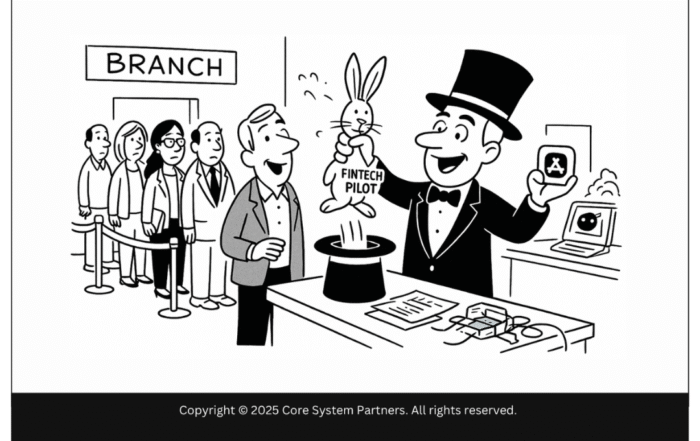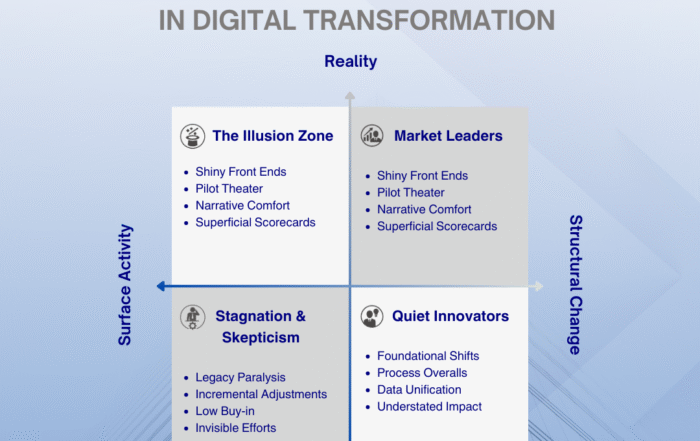
Still patching compliance fixes like it’s 2012? Learn why short-term duct tape solutions are derailing transformation—and how to shift from reactive workarounds to proactive, scalable compliance architecture.
A few years ago, I sat in a transformation kickoff meeting at a regional bank where the IT lead started the session with a joke: “Our compliance stack is like duct tape—it holds everything together until someone breathes on it.” Everyone laughed. But the tension in the room? That was real.
The cartoon captures it perfectly: one side advocating for yet another patch, the other insisting the system itself needs rethinking. Somewhere in between lies the truth most banks live with daily—patch now, plan later. Until “later” becomes never.
Let’s talk about why this happens, why it’s dangerous, and how to get off the compliance patch treadmill before it derails your transformation altogether.
The Compliance Trap: Quick Fixes, Long-Term Costs
Banking compliance is non-negotiable. When a new regulation hits, you can’t afford to wait months to respond. So, we patch. And patch. And patch again.
But here’s the catch: every patch is a trade-off. You might stay on the right side of a regulator today, but you could be compromising tomorrow’s stability, scalability, or security in the process.
Here’s what unchecked compliance patching often creates:
- Spaghetti code that no one wants to touch
- Shadow systems that only one person understands
- Hidden interdependencies that fail during updates
- Data inconsistencies from systems that don’t talk to each other
- Auditor nightmares when documentation can’t keep up
Eventually, you’re not transforming. You’re treading water.
Why Patches Feel Like the Only Option
We get it. Patches are fast. System upgrades are slow. And when you’re under the gun from regulators, boards, or both, the quickest fix feels like the only path.
Here’s what drives the madness:
1. Short-term pressure outweighs long-term planning
When audits, fines, or risk committees loom, strategic upgrades take a backseat.
2. Legacy systems weren’t built for agility
Some core systems are so rigid that even small changes feel like brain surgery.
3. Lack of ownership
When no one owns the full compliance architecture, patches become the default survival tactic.
4. Fear of disruption
The business worries an upgrade might break things, so IT plays it safe—with more duct tape.
Compliance Should Drive Transformation, Not Delay It
Ironically, compliance challenges can be a powerful reason to modernize. Instead of seeing them as obstacles, treat them as catalysts. If you keep patching just to meet regulatory needs, you’re building a house of cards.
A system that’s genuinely fit for purpose:
- Responds quickly to new regulations
- Maintains clean, auditable data trails
- Reduces manual workarounds
- Minimizes risk exposure through clarity and control
Signs Your Compliance Architecture Is Cracking
Wondering if you’re stuck in patch madness? Look for these red flags:
- You rely on a “do not touch” folder to keep things working.
- Every compliance rule lives in a different spreadsheet or module.
- Regulatory changes lead to panic, not planning.
- It takes more time to find data than to report on it.
- Your compliance team has created their own rogue workflows.
Sound familiar? You’re not alone.
From Patching to Planning: What Better Looks Like
Here’s how we’ve helped clients escape the loop—and build transformation-ready compliance systems:
1. Inventory Your Patches
Start with a simple but honest audit. What’s been patched? Why? Who owns it? How many “temporary” fixes are still active 18 months later?
2. Connect Compliance to Core Architecture
Don’t treat compliance as a bolt-on. Bake it into your system design, data governance, and workflow planning.
3. Choose Configurability Over Customization
Invest in systems where new rules can be applied via configuration—not custom code. Flexibility is the name of the game.
4. Build for Transparency
Design systems that surface what’s happening—data lineage, controls, and rule logic—so compliance teams don’t need a translator.
5. Empower Compliance with Real-Time Tools
Give compliance teams access to dashboards, alerts, and analytics—not just emailed reports after the fact.
A Story of Escape
A mid-tier bank we worked with was managing over 30 active patches—each tied to a different regulation. When the FDIC updated guidance around data access controls, panic ensued. Their patch strategy couldn’t keep up.
We helped them shift by implementing:
- A central compliance configuration engine
- Standardized process flows aligned with regulatory categories
- Self-service reporting dashboards
- System-wide tagging of data elements by regulatory impact
The result? Audit response time dropped by 60%, and the compliance team finally moved from reactive firefighting to proactive governance.
Moving Forward
It’s tempting to see patches as “just one more fix.” But each patch is a step further away from a system that actually serves your strategy. Patching is a symptom. The real diagnosis? A system that’s no longer designed for the world it operates in.
You can’t transform your bank by treating every challenge as an isolated issue. Real transformation means stepping back, zooming out, and building something that’s fit for what’s next—not just what’s urgent.
Your Next Step
Ready to move from patchwork to progress?
Take our OptimizeCore® Assessment and uncover where your compliance systems may be holding you back—and what to do about it.
Remember: Transformation isn’t about patching faster. It’s about needing fewer patches in the first place.
#CoreBankingTransformation #CoreBankingOptimization





